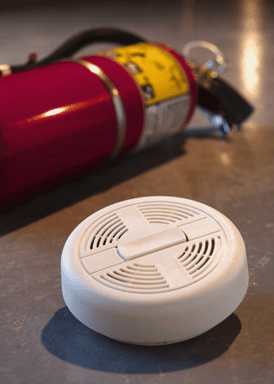
This past November was colder than usual in the U.S. (though it was exceptionally warm elsewhere in the world), which is likely to prompt increased use of heating devices in facilities and cause a corresponding increase in fire hazards.
According to government research, December fires account for an average of 415 deaths and 1,650 injuries, and are typically 8% more costly than fires occurring during other winter months. Facility managers should take care to double check all fire-related systems and protocols to ensure they’re working properly.
For facilities managers who use CMMS software to track assets and inspections, simple checks of fire detection/alert systems, fire extinguishers, and fire hydrants could spell the difference between zero or a minor incident and a multi-million dollar disaster.
Test alarm and smoke detection systems
Commercial facilities typically rely on complex fire detection and alarm systems that incorporate a range of components and devices, including strobe lights, speakers, smoke sensors, programmable command units, sprinklers, etc. Maintenance and testing must therefore be thorough in order to ensure that all of these components are working properly.
Depending on the size of the facility, suppliers of these systems may include routine maintenance services. In cases where they don’t, however, it is worth the time it takes to read through manufacturer manuals and add all recommended maintenance and inspections to schedule groups in your CMMS program.
For residential properties, ensuring that smoke detectors are functioning properly is the single most important fire safety measure. Two-thirds of all fire-related deaths occur on properties that lack functioning smoke detectors.
Beyond these basic checks, there are other checks that can be performed periodically. A detailed breakdown of some of these, along with the intervals at which they should be performed, can be found here.
Inspect fire extinguishers
As mentioned above, December fires tend to be deadlier and costlier than average. This is largely due to increased cooking and holiday decorations, which tend to be containable if they are responded to quickly with functioning fire extinguishers.
Fire extinguishers tend to sit neglected over extended periods of time, gathering dust and other debris that can cause them to malfunction when they’re needed. And because they’re generally used only rarely, they can wind up becoming blocked behind boxes or furniture, making them difficult to find or access, and potentially damaging them over time. Regular should be performed at least monthly to prevent these issues from developing.
Hydrostatic testing also needs to be performed on all extinguishers to ensure that they contain the proper amount of pressure. Certain types of chemical extinguishers need to be shaken as frequently as once per month to prevent certain components from settling or “packing.”
Fire hydrants
ManagerPlus has a client that lost an entire facility to a fire because the nearest fire hydrant didn’t have adequate pressure. Now, they perform hydrant pressure checks as part of a detailed fire-safety preventive maintenance routine, which they implemented using ManagerPlus Enterprise.
Responsibility for testing hydrants will either fall on municipal fire authorities or private property owners themselves. In the case of the latter, it can be easy to forget that hydrant testing must be handled by facility/property managers. The fire department of Colorado Springs, for instance, is only responsible for about three-fourths of fire hydrants in their jurisdiction, leaving some 3,000 must be tested and maintained by private property owners.
Considering the severe consequences associated with fires, it important to review all safety protocols, but the above tips should provide a solid start. Be sure to check back here regularly for all the latest maintenance news, tips, and insights from ManagerPlus.
